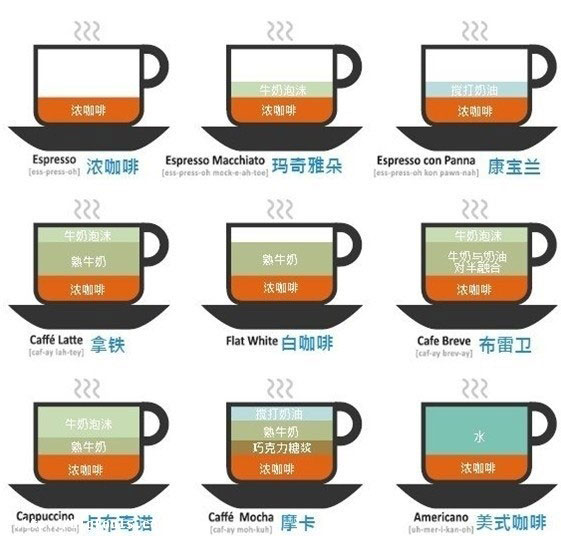Little knowledge: a complete knowledge of coffee

Classification of coffee:
Coffee trees can be roughly divided into five species, of which Arabica and Robusta are the more common. Arabica species accounts for more than 70% of the world's total production. This variety is generally planted on slopes above 900 meters above sea level and is mostly produced in tropical high altitude areas such as Central and South America, East Africa, Southeast Asia and Hawaii. Its pleasant aroma, rich taste, and the tree species need more artificial care, the stability of the temperature and humidity in the climate is also higher, so the price is also more expensive. Roscostat, which is more adaptable to the environment, accounts for 30% of the world's total production. Its flavor is mediocre, bitter, and more importantly, caffeine content is 2 to 3 times that of Arabica. Generally grown on slopes with an altitude of 200 to 600 meters, the requirements for artificial care are very low, so the price is relatively low, and it is mostly used for canned and instant coffee.
Italian coffee:
Espresso means "fast" in Italian. When hot water quickly passes through coffee powder under high pressure, the essence of coffee is fully extracted, completing a rich, aromatic, high alcohol and bitter coffee art.
Macchiato means "marked, spotted" in Italian. She compromised Espresso and Cappuccino, enjoying smooth, creamy foam while drinking rich Espresso.
Cappuccino Cappuccino gets its name because the foam cap on Cappuccino resembles the cap on the cape worn by Catholic Cappuccino priests. Mixing Espresso, Milk, and Foam in proportion makes Cappuccino less bitter than Espresso and more mellow than Foamy, which gives Cappuccino a more acceptable taste.
The difference between Latte and Cappuccino is that Latte has a stronger milk fragrance, and a lot of milk and milk foam fully reconcile the heavy taste of Espresso, making its taste docile and can be used as the first choice for coffee drinkers.
Mocha means chocolate in Italian, and Café Mocha naturally means chocolate coffee. When mellow coffee, rich milk and sweet chocolate are perfectly combined, no one can resist her seductive charm.
[Frappuccino Frappuccino] is blended by Espresso, milk, chocolate powder, etc. After machine shake treatment, the flavor of all materials is integrated. Its taste is real, sweet but not greasy. The chocolate taste has a strong coffee fragrance and a refreshing feeling. It can be said to be a coffee drink suitable for summer.
Coffee brewing:
Italian coffee: generally brewed at home Italian coffee, is the use of Italy invented mocha pot brewing, this coffee pot is also the use of steam pressure principle to quench coffee (another Watt apprentice). Mocha pot can make the pressurized steam directly through the coffee powder, so that the steam instantly passes through the cell wall of the coffee powder (or Hook's apprentice), and the inner essence of the coffee is extracted, so the brewed coffee has a strong aroma and a strong bitter taste, and a thin layer of coffee oil emerges on the surface of the coffee, which is the source of the attractive aroma of Italian coffee.
Kang Baolan, Ma Qiya Duo Coffee: Italian coffee is really "a hundred flowers", and open Kang Baolan and Ma Qiya Duo two flowers to come. Simply add the right amount of whipped cream to your espresso and finish a cup of Combolan with ease. The tender white cream floated gently on the deep coffee, like a white lotus flower that was not stained with mud, making one unable to bear to drink it in one gulp. Espresso is made without whipped cream or milk and with just two tablespoons of creamy foam. Unlike Kang Baolan, if you want to enjoy the delicious taste of Ma Qiya Duo, you have to drink it in one gulp.
French milk coffee: the ratio of coffee and milk is 1:1, orthodox French milk coffee brewing, to milk pot and coffee pot from both sides at the same time into the coffee cup, this red formula continued for hundreds of years. Today, it is still an indispensable drink on the French breakfast table. French baby, full of milk!
Turkish coffee: still using the original cooking method, complex technology with a bit of exotic mystery. From it we can glimpse the splendour of the Ottoman Empire.
Irish coffee: the name with a strong whiskey incense, Irish whiskey as life, but also in the coffee do some tricks! Irish coffee blended with whiskey can better set off the sweet and sour taste of coffee. A hint of mature melancholy…careful, too much coffee will get drunk!
Royal coffee: this is a top-grade but by a levy through the war of the emperor invented, yes, he is the emperor of the french empire napoleon! He didn't like milk. He liked brandy, the pride of France! (Another guy who spiked his coffee!) Blue flame dance brandy aromatic alcohol and sugar burnt incense, and then close to the thick coffee incense, bitter slightly sweet…French pride, French romance.
Green tea coffee: the fragrance of green tea will pull our eyes back from distant countries, Japan is a good absorption and integration of the nation, this time, they have found a balance between western coffee and eastern green tea, but also for tea lovers to provide a new favorite. This is a pure oriental flavor coffee, green tea elegant fragrance, coffee thick thick interaction.
Iced latte: we have to mention latte again. The use of fructose and milk mixed to increase the proportion of milk, so that it will not mix with the lighter proportion of coffee, into two layers of black and white, forming a beautiful visual effect like a cocktail, coupled with ice cubes, giving people an elegant and romantic warm feeling.
Magic Ice Cream Coffee: This creative and varied magic flavor belongs only to young you! Pour espresso on top of cold vanilla ice cream, then mix chocolate sauce on top of whipped cream and ice cream, magic blend of iced coffee, leaving only aroma and freshness in your mouth.
Mocha Frosty Coffee: Chocolate lovers, are you still hungry for frosty chocolate mocha coffee? Blend ice cubes and ice cream in a blender to create a dense visual effect. Add mocha iced coffee and you're done! The entrance is slippery, refreshing and fragrant, giving you a cool afternoon in the summer heat.
Famous coffee everywhere:
Blue Mountain Coffee (BLUEMOUNTAIN): is produced in Jamaica Blue Mountain above 2500 feet above sea level coffee beans, is a slightly sour, soft, with sweet, delicate flavor of coffee; pure Blue Mountain coffee taste, aroma is light, but drink up is very mellow delicate; with aristocratic taste, coffee is the best.
Mocha coffee (MOCHA): At present, the coffee produced in Yemen is the best, followed by the Mocha of Ethiopia; Mocha coffee with lubrication in the acid to strong acid, sweet special good, unique flavor, containing chocolate taste; with the temperament of a noble woman, is a very characteristic pure coffee.
Colombia coffee (COLUMBIA): Colombia coffee to SUPREMO most characteristic, its coffee soft and mellow; with a slight acid to acid, its quality and aroma stability, is a moderate coffee, is used to prepare comprehensive coffee top grade.
MANDELING Coffee (MANDELING): is produced in Indonesia, Sumatra, the most representative coffee; flavor, strong, bitter, taste quite strong, but soft without acid, is the best quality coffee produced in Indonesia.
CHARCALFIRE: A heavily roasted coffee that tastes burnt, bitter without acid, and has an oily appearance on the beans, making it ideal for steam pressurized coffee.
Brazil coffee (SANTOS): Brazil is the world's first coffee producer, produced coffee, mild flavor, slightly sour, slightly bitter, neutral coffee representative, is an indispensable variety of mild coffee blending.
Kenyan coffee (KENYAAA) is a representative coffee cultivated in African highlands. AA stands for its grade, that is, the highest grade. Its coffee beans are round and thick in meat, with good taste and good quality. It is usually lightly roasted. Drinking a cup of Kenya in the morning has a refreshing effect.
Hawaiian coffee (KONAFANCY): coffee cultivated by volcanoes in western Hawaii, and the only coffee variety produced in the United States, with strong taste, strong aroma, strong acid and special flavor. The quality is quite stable, and it is one of the must-buy local products for tourists visiting Hawaii.
Viennese: Austria's most famous coffee, invented by a coachman named Ein Schuberner, and perhaps for this reason, Viennese coffee is occasionally referred to today as a "one-headed carriage." With thick whipped cream and chocolate sweet flavor charms people around the world. White fresh cream, colorful rice sprinkled, very beautiful appearance; through the sweet chocolate syrup, cold fresh cream sipping hot coffee, but also unique flavor!
White Coffee: Malaysia is the only place where authentic white coffee is produced. The coffee that exists on the market now belongs to black coffee. Black coffee is made by roasting coffee beans and caramel at high temperature. This work makes the coffee taste bitter, sour, caramel and carbonized. In health, it will hurt the stomach, get angry, cause melanin precipitation and other disadvantages. White coffee is coffee beans without caramel directly low-temperature roasting, remove the general high-temperature hot fry and charcoal roast scorched, sour taste, but also retain the natural flavor and rich aroma of the original coffee, fragrant and smooth heart. No stomach injury, no fire, low caffeine, smooth taste, mellow fragrance.
Coffee etiquette:
Coffee that is drunk after a meal is generally served in a pocket cup. The ears of this cup are too small for fingers to pass through. But even if you use a larger glass, don't put your finger through the ear before holding it. The correct way to hold a coffee cup should be to pinch the cup handle with your thumb and index finger and then lift the cup.
[How to add sugar to coffee] When adding sugar to coffee, sugar can be scooped up with coffee spoon and added directly to the cup; you can also use sugar clamp to clamp the sugar cube on the close side of the coffee dish, and then use coffee spoon to add sugar cube to the cup. If you put sugar directly into the cup with a sugar clamp or hand, sometimes coffee may spill, thus soiling clothes or tablecloth.
Coffee spoon is specially used to stir coffee, coffee should be taken out. No more spoonfuls of coffee to drink slowly, and don't use coffee spoons to mash sugar cubes in your cup.
Just brewed coffee is too hot, you can use a coffee spoon in the cup gently stir to cool it, or wait for it to cool naturally, and then drink. Trying to blow coffee cold with your mouth is a very rude gesture.
[Use of cups and saucers] The cups and saucers that hold coffee are specially made. They should be placed on the front or right side of the drinker, and the ears should point to the right. When drinking coffee, you can hold the cup ear of coffee with your right hand, gently hold the coffee dish with your left hand, and slowly move to your mouth to sip. It is not advisable to hold the cup full, swallow it, or bow down to the coffee cup. Don't make any noise while drinking coffee. When adding coffee, do not lift the coffee cup from the coffee dish.
[Coffee and snacks] Sometimes you can eat some snacks when you drink coffee, but don't hold a coffee cup in one hand and a snack in the other hand. Eat and drink alternately. Coffee should be put down for snacks, and coffee cups should be put down for snacks.
Coffee terms:
Knowing certain coffee terms will not only allow you to accurately express your understanding of coffee, but will also make your customers or friends feel that you are a coffee expert and a coffee eater.
Flavor is the overall impression of aroma, acidity, bitterness, sweetness and alcohol, which can be used to describe the overall feeling of contrast coffee.
Acidity [acidity] is the sour, strong quality of all coffee grown in the plateau. The sour acrid is different from bitter or sour, and it has nothing to do with pH value, but it is a fresh and lively quality that promotes coffee to exert functions such as boosting the mind and cleansing the taste.
Body [alcohol] is the taste of coffee left on the tongue after drinking the finished coffee. Alcohol varies from watery to light, medium, high, fatty, and even syrupy in some Indonesian coffees.
Aroma refers to the aroma and aroma emitted by coffee after conditioning. Bouquet is a less commonly used word for the taste of ground coffee. Aroma is usually specific and comprehensive. Words used to describe Aroma include: caramel, charred, chocolate, fruity, grassy, malty, rich, rich, spicy, etc.
Bitterness is a basic taste, and the sensory area is distributed in the root of the tongue. The bitterness of dark roasts is deliberately created, but the most common cause of bitterness is too much coffee powder and too little water. Bitterness is not the assent word for sour.
Bland Coffee grown in lowlands and usually quite light and tasteless. Coffee with too little powder and too much water will also have the same light effect.
Briny [salty] coffee brewing, if overheated, will produce a salty taste. Some coffee shops have coffee that tastes like this.
Important Notice :
前街咖啡 FrontStreet Coffee has moved to new addredd:
FrontStreet Coffee Address: 315,Donghua East Road,GuangZhou
Tel:020 38364473
- Prev

The cafe features the operation of a bank and becomes a cafe.
In response to the need to reduce the financial network, the Bank of the United States has hired more manpower and even converted its branches into coffee bars, but customers' reactions to the new marketing methods have been mixed. ■ Firms across the country are tossing out their tellers, adding salespeople and remaking their drive-through lanes.
- Next

The benefits of drinking coffee during pregnancy no more than 1 small cup of coffee a day for girls
Core tip: can you drink coffee during pregnancy? an article published on the babycenter website recently pointed out that excessive caffeine intake during pregnancy can lead to miscarriage, so mothers-to-be are advised to limit their caffeine intake during pregnancy. Can mothers-to-be drink coffee during pregnancy? Ronald J. Ruggiero, an expert in obstetrics and gynecology, recommends that it is best not to drink coffee during pregnancy, but if you must, it is best not to drink more than 1 per day.
Related
- Detailed explanation of Jadeite planting Land in Panamanian Jadeite Manor introduction to the grading system of Jadeite competitive bidding, Red bid, Green bid and Rose Summer
- Story of Coffee planting in Brenka region of Costa Rica Stonehenge Manor anaerobic heavy honey treatment of flavor mouth
- What's on the barrel of Blue Mountain Coffee beans?
- Can American coffee also pull flowers? How to use hot American style to pull out a good-looking pattern?
- Can you make a cold extract with coffee beans? What is the right proportion for cold-extracted coffee formula?
- Indonesian PWN Gold Mandrine Coffee Origin Features Flavor How to Chong? Mandolin coffee is American.
- A brief introduction to the flavor characteristics of Brazilian yellow bourbon coffee beans
- What is the effect of different water quality on the flavor of cold-extracted coffee? What kind of water is best for brewing coffee?
- Why do you think of Rose Summer whenever you mention Panamanian coffee?
- Introduction to the characteristics of authentic blue mountain coffee bean producing areas? What is the CIB Coffee Authority in Jamaica?

